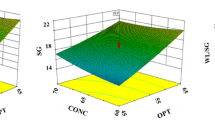Abstract
An osmotic-dehydration process protocol for Carambola (Averrhoacarambola L.,), an exotic star shaped tropical fruit, was developed. The process was optimized using Response Surface Methodology (RSM) following Central Composite Rotatable Design (CCRD). The experimental variables selected for the optimization were soak solution concentration (°Brix), soaking temperature (°C) and soaking time (min) with 6 experiments at central point. The effect of process variables was studied on solid gain and water loss during osmotic dehydration process. The data obtained were analyzed employing multiple regression technique to generate suitable mathematical models. Quadratic models were found to fit well (R2, 95.58 - 98.64 %) in describing the effect of variables on the responses studied. The optimized levels of the process variables were achieved at 70°Brix, 48 °C and 144 min for soak solution concentration, soaking temperature and soaking time, respectively. The predicted and experimental results at optimized levels of variables showed high correlation. The osmo-dehydrated product prepared at optimized conditions showed a shelf-life of 10, 8 and 6 months at 5 °C, ambient (30 ± 2 °C) and 37 °C, respectively.

Similar content being viewed by others
References
Abd-Karim A, Chee-Wai C (1999) Foam mat drying of star fruit (Averrhoacarambola. L) puree. Stability and air drying characteristics. Food Chem 64:337–343
Abdullah Liew AG, Sulaiman NM, Aroua MK, Megat MJ, Mohd N (2007) Response surface optimization of conditions for clarification of carambola fruit juice using a commercial enzyme. J Food Eng 81:65–71
Abdullah A, Cheng TC (2001) Optimization of reduced calorie tropical mixed fruits jam. Food Qual Pref 12:63–68
Abdullah MZ, Mohamad-Saleh J, Fathinul-Syahir AS, Mohd-Azemi BMN (2006) Discrimination and classification of fresh-cut star fruits (Averrhoacarambola L.) using automated machine vision system. J Food Eng 76:506–523
AOAC. Official methods of Analysis (1990) Association of Official Analytical Chemists Inc. 15th Edn. Arlington, Virginia, USA
Barat JM, Fito P, Chiralt A (2001) Modeling of simultaneous transfer and structural changes in fruit tissues. J Food Eng 49:77–85
Benzie IFF, Szento YT (1999) Total antioxidant capacity of teas by ferric reducing/antioxidant power assay. J Agri Food Chem 47:633–636
Chau CF, Chen CH, Lin CY (2004) Insoluble fiber rich fractions derived from Averrhoacarambola: hypoglycemic effects determined by in vitro methods. LWT- Food Sci Technol 37:331–335
Chauhan OP, Ajay S, Asha S, Raju PS, Bawa AS (2011) Effect of osmotic agents on colour, textural, structural, thermal and sensory property of osmotically dehydrated apple slices. Int J Food Properties 14:1037–1048
Corzo O, Gomez ER (2004) Optimization of osmotic dehydration of cantaloupe using desired function methodology. J Food Eng 64:213–319
Larmond E (1977) Laboratory methods for sensory evaluation of foods. Canada Department of Agriculture publication. Ottawa, 1637
Mauro MA, Shinematsu E, Eik NM, Kimura M (2005) Osmotic dehydration and air kinetics of star fruit (Averrhoacarambola, L) 2nd Mercosur congress on chemical engineering and 4th Mercosur congress on process system engineering. 14-15th Aug 2005, ENPROMER, Costa Verde-RJ, Brazil
Moreira R, Sereno MA (2003) Evaluation of mass transfer coefficient and volumetric shrinkage during osmotic dehydration of apple using sucrose solution in static and non-static condition. J Food Eng 57:25–31
Mujica-Paz H, Valdez-Fragoso A, Lopez-Malo A, Palou E, Welti-Chanes J (2003) Impregnation and osmotic dehydration of some fruits: effect of the vacuum pressure and syrup concentration. J Food Eng 57:305–314
Mullen K, Ennis DM (1979) Rotatable design in product development. Food Technol 33:74–80
Murcia MA, Jimenez AM, Martinez Tome M (2001) Evaluation of the antioxidant properties of Mediterranean tropical fruits compared with common food additives. J Food Prot 64:2037–2046
Perez-Tello GO, Silva Espinoza BA, Vargas Arispuro I, Briceno Torres BO, Martinez Tellez MA (2001) Effect of temperature on enzymatic and physiological factors related to chilling injury in carambola fruit (Averrhoacarambola L.). Biochem Biophys Res Comm 287:846–851
Pino JA, Marbot R, Aguero J (2000) Volatile components of star fruit (Averrhoacarambola L.). J Essen Oil Res 12:429–430
Prati P, Nogueira JN, Dias CT dos S (2002) Evaluation of star fruit (AverrhoacarambolaL.) sweet and sour for the canned processing. Boletim do Centro de Pesquisa e Processamento de Alimentos 20:221-246
Ruiz-Lopez II, Ruiz-Espinosa H, Herman-Lara E, Zarate-Castillo G (2011) Modeling of kinetics, equilibrium and distribution data of osmotically dehydrated carambola (Averrhoacarambola L.) in sugar solutions. J Food Eng 104:218–226
Singleton VL, Rosi JA (1965) Colorimetry of total phenolics with phosphomolybdic-phosphotungustic acid reagent. Am J Enology Viticulture 16:144–158
Soyad TT (1999) Method of making a carambola beverage. Patent US 5928698
Teixeira Gustavo HA, Durigan Jose F, Alves Ricardo E, O’Hare Timothy J (2008) Response of minimally processed carambola to chemical treatments and low-oxygen atmospheres. Postharvest Biol Technol 48:415–421
Wang CS, Wei YP, Swi Bea Wu J (1998) Reduction of oxalic acid content in sour carambola juice by evaporation concentration and precipitate removal. Food Sci Taiwan 25:490–496
Weller A, Sims CA, Mathews RF, Bates RP, Brecht KN (1997) Browning susceptibility and changes in composition during storage of carambola slices. J Food Sci 62:256–260
Yusof S, Lee kC (1997) Effect of brix processing techniques and storage temperature on the quality of carambola fruit cordial. Food Chem 59:27–32
Zhishen J, Mengcheng T, Jianming W (1999) The determination of flavonoids content in mulberry and their scavenging effects on superoxide radicals. Food Chem 54:555–559
Author information
Authors and Affiliations
Corresponding author
Rights and permissions
About this article
Cite this article
Roopa, N., Chauhan, O.P., Raju, P.S. et al. Process optimization for osmo-dehydrated carambola (Averrhoa carambola L) slices and its storage studies. J Food Sci Technol 51, 2472–2480 (2014). https://doi.org/10.1007/s13197-012-0756-2
Revised:
Accepted:
Published:
Issue Date:
DOI: https://doi.org/10.1007/s13197-012-0756-2




